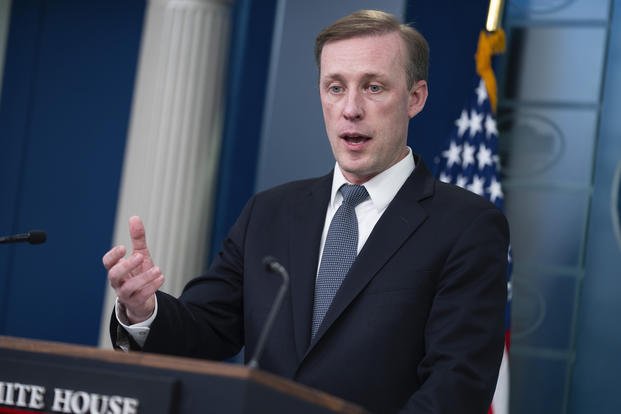With tens of billions of dollars to support Ukraine's war effort finally approved by Congress, a top U.S. official said this week that the United States is ready to train more Ukrainian troops if called upon, though the Eastern European country continues to face recruiting challenges as its war to repel Russian invasion stretches into its third year.
Speaking to a small group of reporters at the White House on Thursday, National Security Adviser Jake Sullivan said the United States and its allies are ready to expand training. Currently, while there are U.S. military advisers in Ukraine, they are not training local forces. All U.S.-supported training has taken place outside of the country.
"You've got to generate the people, and then having generated the people, you determine, does it make sense for them to do their basic training in Ukraine? Does it make sense for them to go into a unit training in one of these outside-Ukraine facilities where we are doing training, where our partners are doing training?" Sullivan said in response to a question from Military.com.
"We're at the stage right now where that's a consultation among partner militaries, the U.S. and Ukraine, and it's ultimately up to Ukraine to say, 'Here's our need, can you can you meet it?'" he added.
Sullivan's comments come after a hard-fought political victory for the Biden administration with Congress' approval earlier this week of roughly $61 billion in military, humanitarian and economic assistance for Ukraine.
Amid dire warnings from U.S. military officials about the consequences of failing to approve more funding for Ukraine, lawmakers dithered for months on passing the aid bill. It finally cleared Congress with large bipartisan majorities in both chambers after House Speaker Mike Johnson, R-La., bucked hard-right members of his party to give the bill a vote.
The largest chunk of military funding in the bill and the part getting the most attention is the more than $30 billion to replenish U.S. military stockpiles that have been sent to Ukraine and buy that country new weapons. U.S. weapons shipments to Ukraine stopped and Ukrainian forces had to start rationing ammunition during the political fight over the bill after money to replenish American stockpiles ran out. Administration officials are now working to rush weapons to Ukraine with the funding approved.
But the bill also includes about $11.3 billion for U.S. military operations in Europe, including ongoing American military training for Ukrainian forces.
After a brief pause in training at the beginning of the war in 2022 because U.S. trainers left Ukraine ahead of Russia's invasion, American forces have been training Ukrainians in Germany, with the training evolving for different phases of the war and to incorporate new weapons systems.
Meanwhile, Ukrainian leaders are working to replenish their forces after two years of war and recent battlefield losses have left the ranks exhausted and depleted. Earlier this month, Ukrainian President Volodymyr Zelenskyy signed a law that lowers Ukraine's draft age to 25 and another that requires all men between 18 and 60 to carry military registration documents and present them to officials when asked.
At his roundtable with reporters, Sullivan said "step one" for any expanded military training is to see how Ukraine's efforts to bolster its forces go.
"Then step two is to look at whether that means having to expand or adjust the training that's taking place in Europe outside of Ukraine by the United States and other militaries," he said, adding that Defense Secretary Lloyd Austin has been discussing the topic with allies through the Ukraine Defense Contact Group. "So from our perspective, being able to expand and enhance training is something that we're set up and ready to do. The real question is one of throughput and at what point does it become necessary to, say, take additional personnel from Ukraine and put them through that training."
In addition to the training the United States is doing in Europe, a dozen Ukrainian pilots are being trained on F-16 Fighting Falcon fighter jets at a National Guard base in Arizona. U.S. and European officials have previously estimated that F-16s could start flying in Ukraine by mid-summer.
Asked whether the timeline for finishing the first round of F-16 training and getting the jets to Ukraine is still on track for the summer, Sullivan said that the process is "moving" but that he "can't give you a date on when we'll see the first deployments to Ukraine."












